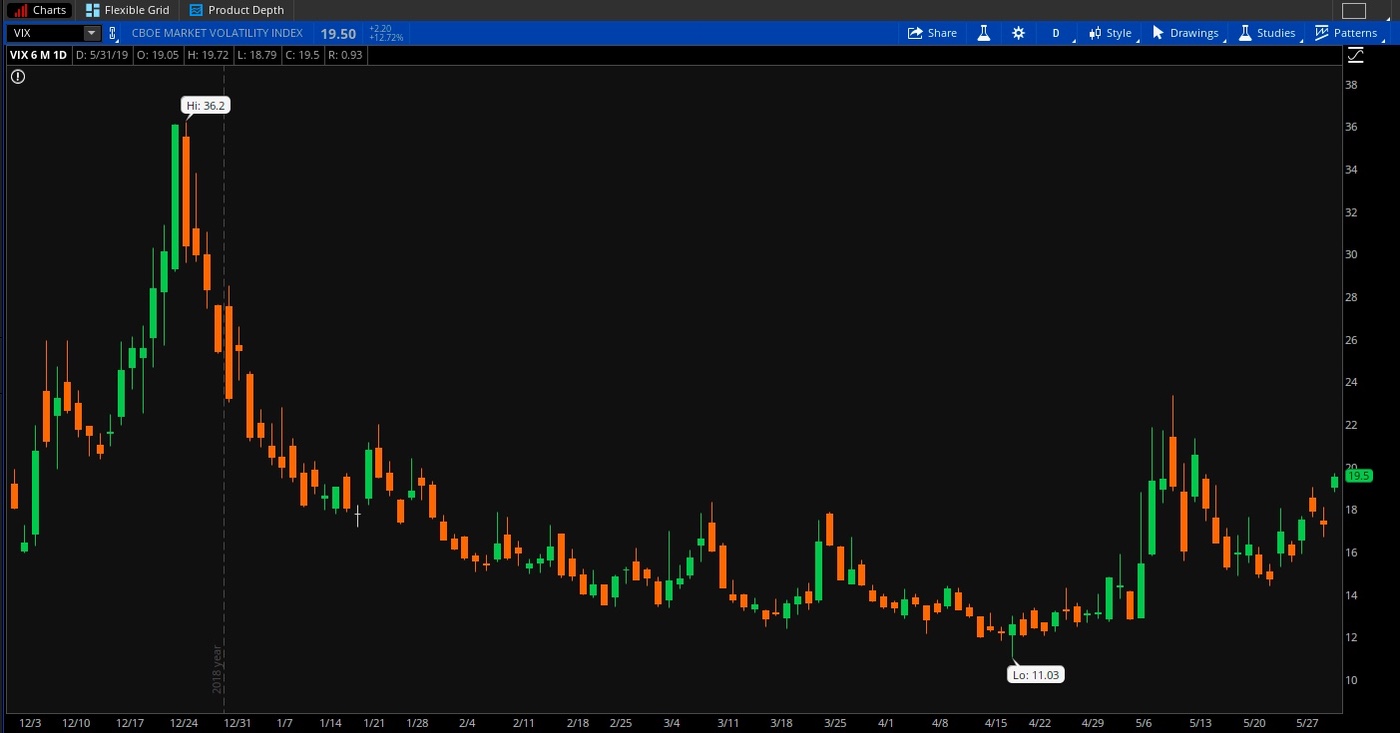(Friday Market Open) You may have heard of the Wall Street adage “sell in May and go away.” As the last trading session of this month gets underway, it seems clear that at least the first part of that has come true.
The S&P 500 Index (SPX) had already lost more than 5% over the month through Thursday’s close, and things aren’t looking great for the bulls in early going today.
The latest headwind for the market? You guessed it: Fresh trade worries. But this time the big news wasn’t about U.S.-China trade relations.
In a big surprise, President Trump late Thursday threatened to impose a 5% tariff on all goods from Mexico, starting on June 10. He said that the tax would gradually increase “until the illegal immigration problem is remedied, at which time the tariffs will be removed.”
The news sent shares of General Motors (NYSE:GM), Ford (NYSE:F) and Fiat Chrysler (NYSE:FCAU) tumbling in pre-market trading as they import vehicles and parts from Mexico. And Treasury yields fell as investors flocked to the relative safety of U.S. government debt.
Meanwhile crude futures were under pressure amid concerns about demand amid increased U.S. and Saudi production.
Tariff Exhaustion
Trump’s announcement on Mexico tariffs comes at a time when the market has already been under tariff-related pressure concerning China. There’s no end in sight to the U.S.-China trade war and many market participants seem to have reached a point of exhaustion with the China tariff situation.
For months, there’s been an almost daily back-and-forth where the market rises strongly one session when there has been optimistic news on the trade front, only to have those hopes dashed and stocks retreat in another session based on fresh commentary from U.S. or Chinese trade negotiators.
That indecision, over a prolonged period, seems to have led investors to move out of equities and into U.S. government debt, even before the Mexico announcement. Perhaps that’s because they registered decent stock market gains earlier in the year, and now may want to take some profits and wait out the stormy trade winds.
Where’s The Bargain Hunting?
One thing that’s worrisome at the moment is that it doesn’t seem like much bottom fishing, or bargain hunting, has been going on. There doesn’t seem to be a sector that, when stocks in it reach a certain low, people come in to buy, like we’ve seen with chipmakers and FAANG stocks in the past.
On Thursday, the market took a bit of a break from the selling but didn’t push convincingly higher, as stocks managed to eke out slight gains, perhaps as investors wanted to reassess whether the recent selling had brought valuations down to a level that matches the currently low appetite for risk.
On that front, longer-term bond yields fell as investors continued to buy Treasuries because of the relative safety of stable U.S.-government-backed debt. Meanwhile, the yield on the three-month Treasury was higher than that of the 10-year Treasury, a so-called inversion that is also in place this morning. Some economists say an inverted yield curve is sometimes the sign of a pending recession, though others say the relationship isn’t necessarily an accurate prediction.

FIGURE 1: VOLATILITY CREEP. The Cboe Volatility Index (VIX) has been creeping up in recent days along with investor angst about the U.S.-China trade war. With worries ratcheting up because of the Mexico news, we’ll have to see if it hits the 20 mark today. Data Source: Cboe Global Markets. Chart source: The thinkorswim® platform from TD Ameritrade. For illustrative purposes only. Past performance does not guarantee future results.
Strong GDP: Although the latest government figure showed Q1 gross domestic product that was revised slightly lower, the first three months of the year are still proving to show decent growth. The second estimate for Q1 GDP came in at an annualized rate of 3.1%. That was in line with a Briefing.com consensus expectation and down just slightly from the 3.2% estimate last month. If you’ll recall, in its first estimate of Q1 GDP, the Commerce Department said the benchmark measure of economic activity rose at a 3.2 annual rate when a Briefing.com consensus had expected a growth rate of 1.9%. “The key takeaway from the report is that it is backward looking (we're nearly two months into the second quarter), which diminishes its market-moving impact,” Briefing.com said of the new figure. “Still, it reinforces the notion that first quarter growth was better than most thought it would be before the quarter started.”
Consumer Confidence: It’s interesting that the latest consumer confidence survey from the Conference Board came in stronger than expected, given the cutoff date for preliminary results was May 16, well after the breakdown in U.S.-China trade talks earlier in the month. The May index came in at 134.1, compared to a Briefing.com consensus estimate of 130. The better-than-expected number offers a bright spot for the U.S. economy amid the threat of a protracted trade war because the U.S. consumer is expected to foot the bill. Consumers just don’t seem that worried. “Consumers expect the economy to continue growing at a solid pace in the short-term, and despite weak retail sales in April, these high levels of confidence suggest no significant pullback in consumer spending in the months ahead,” the Conference Board said. Still, market sentiment has soured even more since then, and we’ll have to wait and see whether that bleeds into the next Conference Board consumer confidence figures.
Bond Proxies: There is a potential bright spot to consider looking out for when it comes to lower government debt yields. At some point that could encourage investors to buy more dividend stocks as they search for higher yields. This could be a boon especially for the defensive Utility and Real Estate sectors. These sectors are considered bond proxies because of their history of stable payouts and their relative safety compared with more cyclical equities sectors, whose returns tend to be more sensitive to the ebb and flow of the economy.
Disclaimer: Charts For illustrative purposes only. Past performance does not guarantee future results.TD Ameritrade® commentary for educational purposes only. Member SIPC. Options involve risks and are not suitable for all investors. Please read Characteristics and Risks of Standardized Options.
